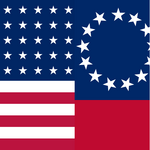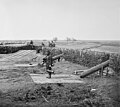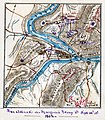Portal:American Civil War
 |
 |

The American Civil War (1861–1865) was a sectional rebellion against the United States of America by the Confederate States, formed of eleven southern states' governments which moved to secede from the Union after the 1860 election of Abraham Lincoln as President of the United States. The Union's victory was eventually achieved by leveraging advantages in population, manufacturing and logistics and through a strategic naval blockade denying the Confederacy access to the world's markets.
In many ways, the conflict's central issues – the enslavement of African Americans, the role of constitutional federal government, and the rights of states – are still not completely resolved. Not surprisingly, the Confederate army's surrender at Appomattox on April 9,1865 did little to change many Americans' attitudes toward the potential powers of central government. The passage of the Thirteenth, Fourteenth and Fifteenth amendments to the Constitution in the years immediately following the war did not change the racial prejudice prevalent among Americans of the day; and the process of Reconstruction did not heal the deeply personal wounds inflicted by four brutal years of war and more than 970,000 casualties – 3 percent of the population, including approximately 560,000 deaths. As a result, controversies affected by the war's unresolved social, political, economic and racial tensions continue to shape contemporary American thought. The causes of the war, the reasons for the outcome, and even the name of the war itself are subjects of much discussion even today. (Full article)
The 2nd West Virginia Cavalry Regiment served in the Union Army during the American Civil War. It was organized in Parkersburg, Virginia (now West Virginia) during September 1861. Most of the original members of this regiment were from southeastern Ohio, and planners thought that this regiment would become the 4th Ohio Cavalry. Their application was rejected by the governor of Ohio, so the unit became the 2nd Regiment of Loyal Virginia Volunteer Cavalry. The "Loyal Virginia" part of the name was replaced with "West Virginia" after the state of West Virginia was officially admitted to the Union in 1863. Today, the National Park Service lists them as 2nd Regiment, West Virginia Cavalry under a heading of Union West Virginia Volunteers.
The regiment's first full–fledged war experience happened in early January 1862 in northeastern Kentucky, where they assisted the command of Colonel James A. Garfield. For the next two years, most of the regiment's fighting was in the mountainous backwoods of what later became the southern portion of West Virginia, especially the Kanawha River Valley. During the Kanawha Campaign in September 1862, the 2nd Regiment of Loyal Virginia Volunteer Cavalry cleared away Confederate cavalry that intended to prevent a retreating Union Army from reaching the safety of Ohio. By 1864, the regiment was part of the Army of West Virginia, and spent much of its time fighting in the western portion of today's state of Virginia. It participated in General David Hunter's unsuccessful raid on Lynchburg and Union General Philip Sheridan's Shenandoah Valley Campaign, playing an important part in the Third Battle of Winchester. (Full article...)
During the American Civil War, the state of Illinois was a major source of troops for the Union Army (particularly for those armies serving in the Western Theater of the Civil War), and of military supplies, food, and clothing. Situated near major rivers and railroads, Illinois became a major jumping off place early in the war for Ulysses S. Grant's efforts to seize control of the Mississippi and Tennessee rivers. Statewide, public support for the Union was high despite Copperhead sentiment.
The state was energetically led throughout the war by Governor Richard Yates. Illinois contributed 250,000 soldiers to the Union Army, ranking it fourth in terms of the total manpower in Federal military service. Illinois troops predominantly fought in the Western Theater, although a few regiments played important roles in the East, particularly in the Army of the Potomac. Several thousand Illinoisians were killed or died of their wounds during the war, and a number of national cemeteries were established in Illinois to bury their remains. In addition to President Abraham Lincoln, a number of other Illinois men became prominent in the army or in national politics, including generals, Ulysses S. Grant, John M. Schofield and John A. Logan, Senator Lyman Trumbull, and Representative Elihu P. Washburne. No major battles were fought in the state, although several river towns became sites for important supply depots and "brownwater" navy yards. Several prisoner of war camps and prisons dotted the state after 1863, processing thousands of captive Confederate soldiers. (Full article...)
William Yarnel Slack (August 1, 1816 – March 21, 1862) was an American lawyer, politician, and military officer who fought for the Confederate States of America during the American Civil War. Born in Kentucky, Slack moved to Missouri as a child and later entered the legal profession. After serving in the Missouri General Assembly from 1842 to 1843, he fought as a captain in the United States Army for fourteen months during the Mexican–American War, beginning in 1846. He saw action at the Battle of Embudo Pass and the Siege of Pueblo de Taos. Returning to a legal career, Slack became influential in his area.
After the outbreak of the American Civil War in April 1861, Slack, who held pro-slavery views, supported the Confederate cause. When the Missouri State Guard (MSG) was formed the next month to oppose the Union Army, he was appointed as a brigadier general in the MSG's 4th Division. After participating in the Battle of Carthage in July, he fought in the Battle of Wilson's Creek on August 10. After a surprise Union attack, Slack's deployment of his division gave time for further Confederate States Army and MSG troops to deploy. Suffering a bad hip wound at Wilson's Creek, he was unable to rejoin his command until October. (Full article...)
- ... that some historians believe that Steele's Greenville expedition marked a shift in the Union's war policy?
- ... that Chinese-born Joseph Pierce enlisted as a Union Army soldier, fought at the Battle of Gettysburg during the American Civil War, and was made a corporal?
- ... that after the Little Rock campaign, Union forces held three-quarters of Arkansas?
- ... that Colonel Bradley Winslow was brevetted by US president Abraham Lincoln for "brave and gallant conduct" during the siege of Petersburg in the American Civil War?
- ... that Carter Moore Braxton fought for the Confederacy throughout the American Civil War and, according to one report, had seven horses killed under him but avoided any wounds?
- ... that Charles Herman Allen, university administrator and American Civil War captain, opened the University of Wisconsin to female enrollment in 1863?
- Attention needed
- ...to referencing and citation • ...to coverage and accuracy • ...to structure • ...to grammar • ...to supporting materials
- Popular pages
- Full list
- Cleanup needed
- The West Tennessee Raids
- Requested articles
- James Ashby (soldier) • Benjamin D. Fearing • James B. Speers • Charles S. Steedman • Battle of Barton's Station • Lawrence P. Graham • Frederick S. Sturmbaugh • Davis Tillson • Action at Nineveh (currently a redirect) • International response to the American Civil War • Spain and the American Civil War • Savannah Campaign Confederate order of battle • Native Americans in the American Civil War (currently disambiguation after deletion) • Battle of Lafayette • Battle of Sunshine Church • Requested American Civil War Medal of Honor recipients
- Expansion needed
- Battle of Boonsborough • Battle of Guard Hill • Battle of Rice's Station • Battle of Simmon's Bluff • Battle of Summit Point • Charleston Arsenal • Edenton Bell Battery • First Battle of Dalton • Blackshear Prison • Edwin Forbes • Hiram B. Granbury • Henry Thomas Harrison • Louis Hébert (colonel) • Benjamin G. Humphreys • Maynard Carbine • Hezekiah G. Spruill • Smith carbine • Edward C. Walthall • Confederate States Secretary of the Navy • Confederate States Secretary of the Treasury • David Henry Williams • Battle of Rome Cross Roads • Delaware in the American Civil War • Ironclad Board • United States Military Railroad • Kansas in the American Civil War • Rufus Daggett • Ebenezer Magoffin • Confederate Quartermaster-General's Department • First Corps, Army of Northern Virginia • Francis Laurens Vinton • Henry Maury • Smith's Expedition to Tupelo • Other American Civil War battle stubs • Other American Civil War stubs
- Images needed
- Battle of Lone Jack • Preston Pond, Jr. • Melancthon Smith
- Merging needed
- 1st Regiment New York Mounted Rifles and 7th Regiment New York Volunteer Cavalry
- Citations needed
- 1st Alabama Cavalry Regiment (Union) • 4th Maine Battery • 33rd Ohio Infantry • 110th New York Volunteer Infantry • Battle of Hatcher's Run • Camp Dennison • Confederate colonies • CSS Resolute • Dakota War of 1862 • Florida in the American Civil War • Ethan A. Hitchcock (general) • Fort Harker (Alabama) • Gettysburg (1993 film) • Iowa in the American Civil War • Second Battle of Fort Sumter • Samuel Benton
- Translation needed
- Add an article here!
The following Wikimedia Foundation sister projects provide more on this subject:
-
Commons
Free media repository -
Wikibooks
Free textbooks and manuals -
Wikidata
Free knowledge base -
Wikinews
Free-content news -
Wikiquote
Collection of quotations -
Wikisource
Free-content library -
Wikiversity
Free learning tools -
Wikivoyage
Free travel guide -
Wiktionary
Dictionary and thesaurus
- Shortcuts to this page: Portal:ACW • P:ACW





































































